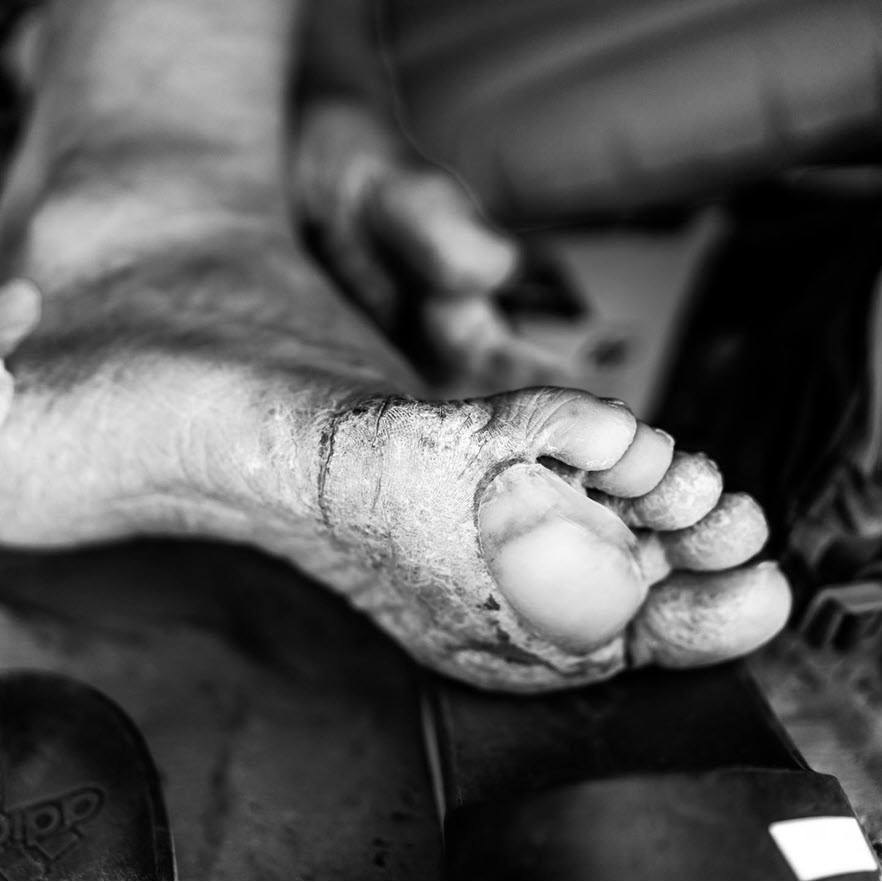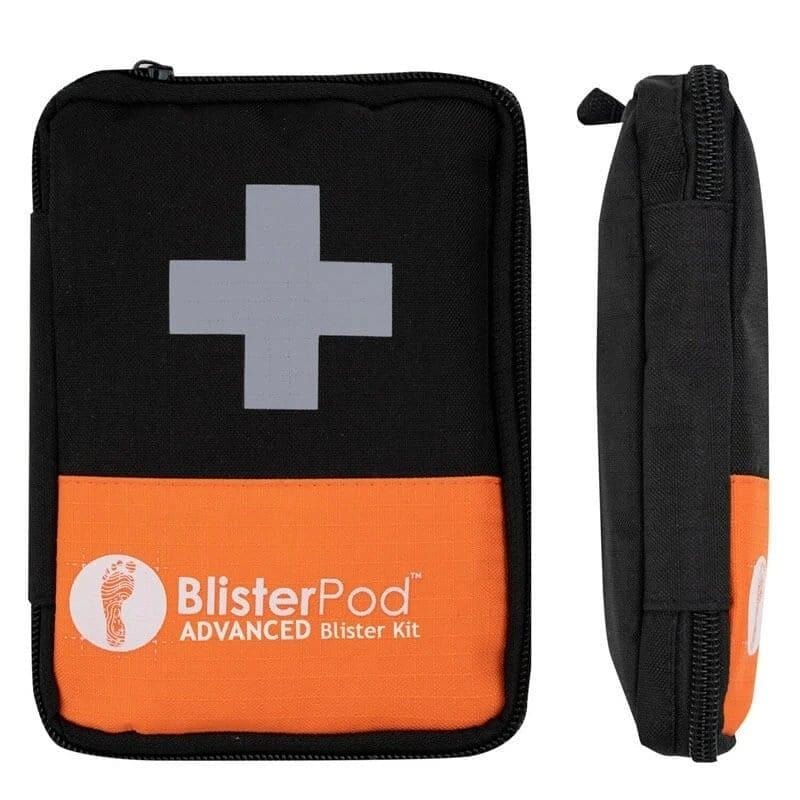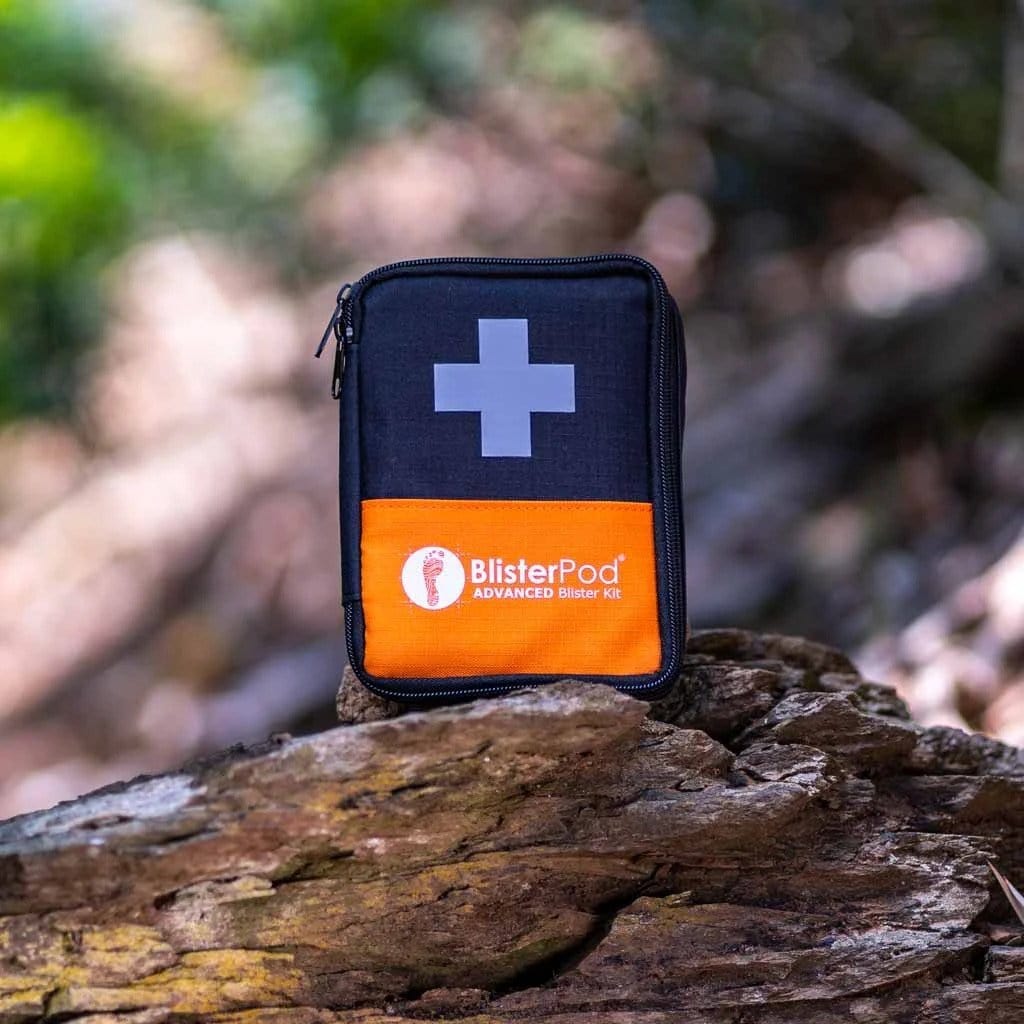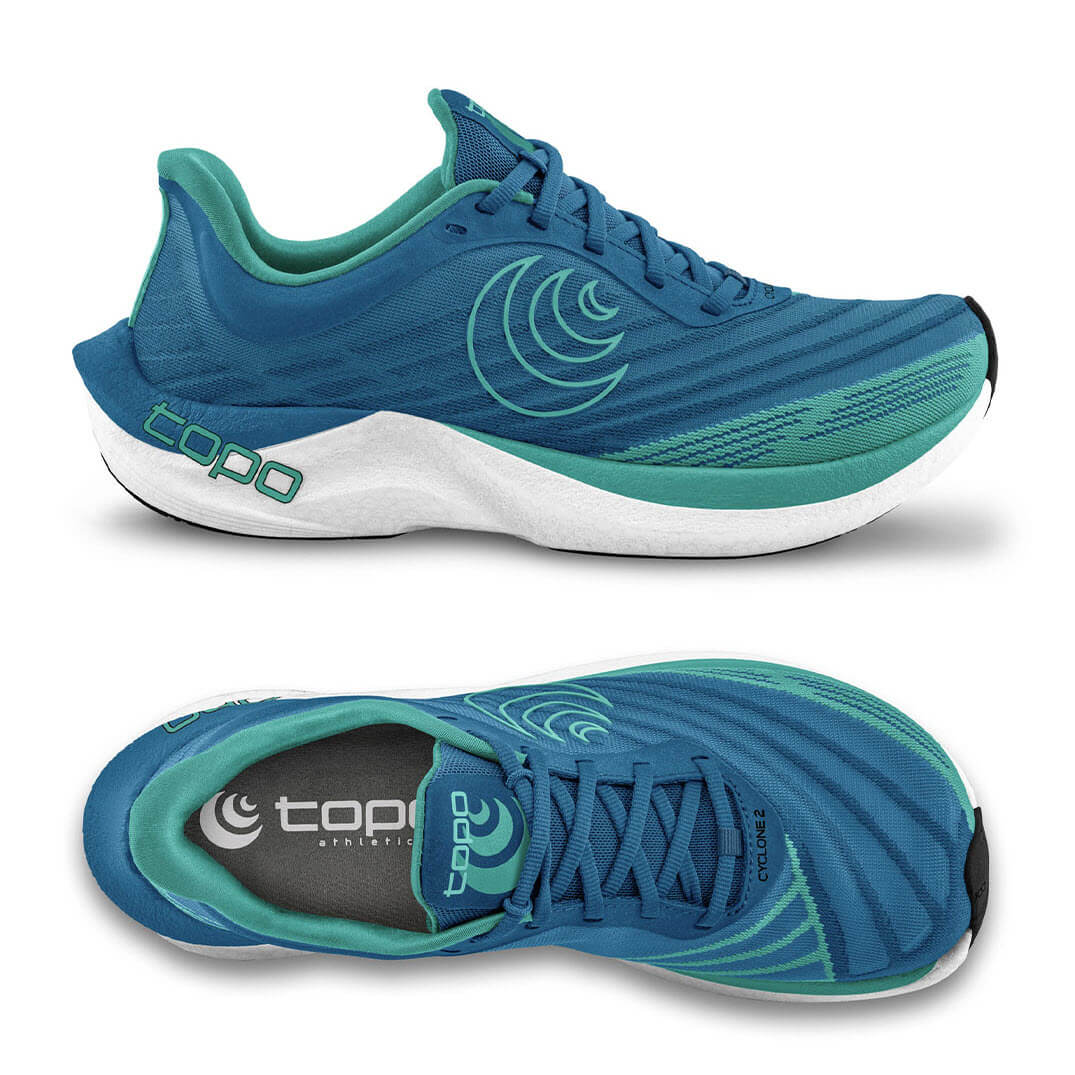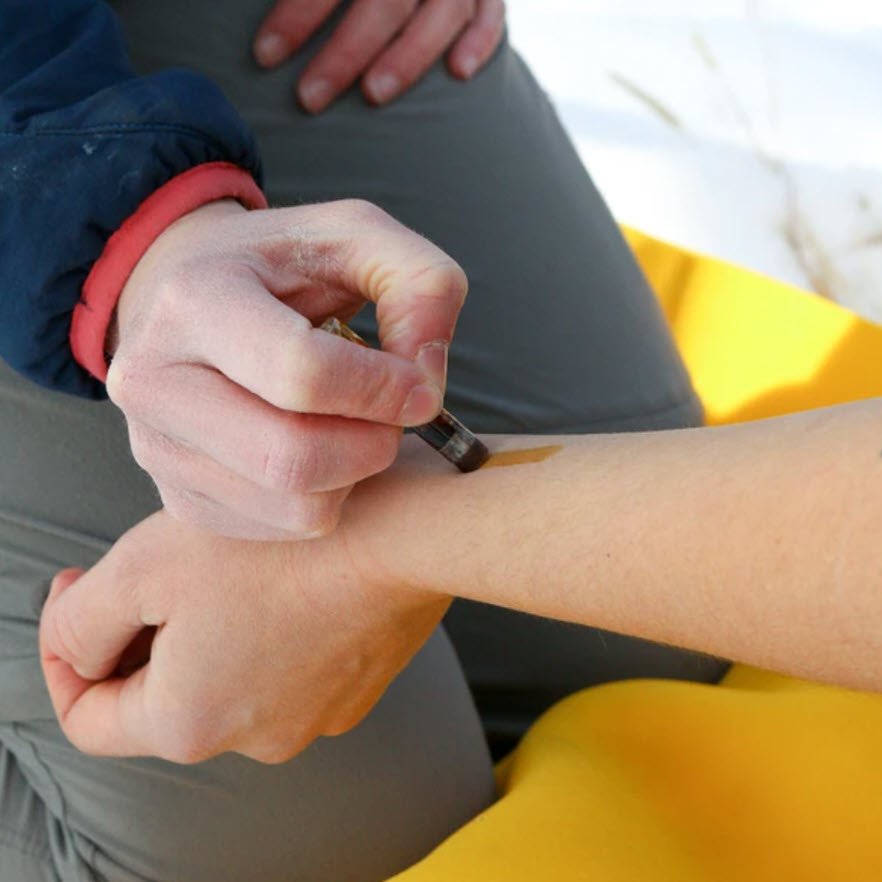It’s important to change your blister dressing at the right time. Otherwise, you risk infection, maceration or delayed healing. Read on for answers to frequently asked blister dressing questions. Watch this video to learn about the stages of blister development and which blister dressing to use at each stage
Q) How Often Should I Change My Island Dressing?
For an island dressing, you change it once you see strikethrough . In fact, just before that if you can. Strikethrough is where you can see your dressing is soiled all the way through. As soon as the absorbent island of your dressing gets wet and soggy, germs can pass straight through it. So, take the old one off, reapply some antiseptic and put a new island dressing on. You might only need to do this once a day, or might need to do is 5 or more times a day. It really depends on what you’re doing and how weepy it is.
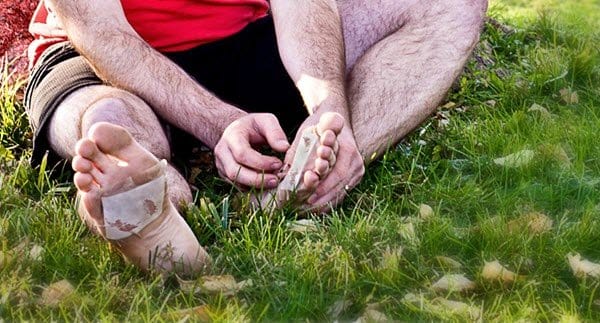
Strikethrough is where blister fluids (or blood in this case) leak through the dressing
By the way, strikethrough can happen from the inside out. Like when you intact blister spontaneously pops and releases blister fluid. Or if your torn or deroofed blister is particularly weepy. And it can happen from the outside in too. Like if you have a shower, or your shoes get soaking wet from watering the garden or running in the rain. All of these waterlogging situations for your island dressing mean bacteria can pass straight through it and infect your blister. Not only that, leaving a soggy island dressing on your foot will cause the skin to macerate. Macerated skin will delay healing. Learn more about maceration here.
Q) How Often Should I Change My Hydrocolloid Dressing?
As for the hydrocolloid blister dressings, they stay on for days at a time. They’re waterproof, so fluids and bacteria can’t pass through. You don’t get strikethrough with these dressings. Instead, the fluid tracks sideways, towards the edge of the bandage. As your raw blister base weeps, the hydrocolloid particles absorb this moisture and it forms a gel, turning a white colour. This moist gelly environment is the perfect environment for rapid skin healing of deroofed blisters. It ensures strong resilient skin will grow back from the outer edge, all the way into the middle of the blister, instead of a dry irritating brittle scab forming over the top, which really, has a raw blister base underneath it. So, you can think of this white bubble as a sign that your blister is healing. But when the white bubble reaches the edge of the plaster, that’s when germs can get into your blister. The plaster will lift at this edge, fluid will leak out and germs can make their way in. So change it just before that happens to ensure your blister doesn’t get infected.
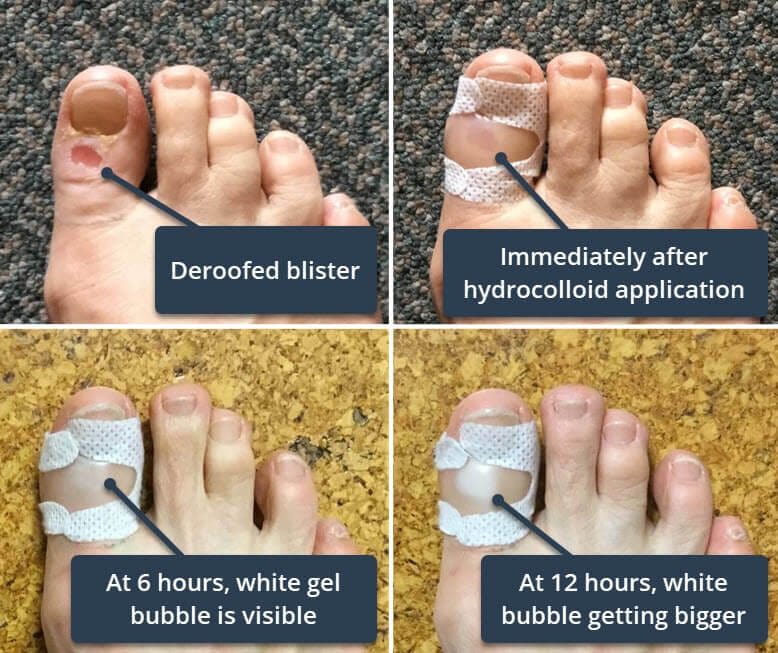
Ideally, don’t be changing your hydrocolloid every day. Your deroofed blister will benefit more from the uninterrupted hydrocolloid healing environment. Besides, it’s just a waste of this very special material. If your blister base is still weepy enough to require daily dressing changes, use an island dressing for a few days (changing it when you see strikethrough) then pop a hydrocolloid on when the weepiness settles down a bit. Learn more about how to use hydrocolloid blister dressings properly here.
Note: Do This At Every Dressing Change
Monitor for infection. Just because your blister isn’t infected now, doesn’t mean it will remain uninfected. So, at each dressing change, look for the signs of blister infection. Incidentally, how will you know If your blister is infected? Well, you might notice increasing pain and redness around the blister, or you might even notice pus. Pus is yellow and often a bit stringy, whereas blister fluid is a clear thin fluid. And by the way, if you notice red streaks extending away from your blister, you’ve got a spreading infection that really needs medical attention to stop it from getting worse. So keep applying your antiseptic or antibiotic, until you get that medical treatment.
Q) What Happens If I Leave My Dressing On Too Long?
If your blister is really weepy and you leave your dressing on too long, the surrounding skin will macerate. This will delay healing.
Q) How Can I Tell When My Blister No Longer Needs Dressings?
When it is no longer weeping. No matter which dressing you've been using (island or hydrocolloid), as soon as your blister is healed enough that it's no longer weeping (no fluid visible on your island dressing / no white gel dot on your hydrocolloid), you no longer have to dress it. The skin is intact enough to prevent infection at this stage. You may choose to continue with an island dressing for a little longer, just to provide a bit of protection to this just-healed skin as it is still a little fragile. As a rough guide, your blister should be healed enough so it’s no longer weeping after about a week. Of course, it will depend a lot on your activity and whether you’ve taken away the blister -causing factors.
Q) I've Been Using A Hydrocolloid On My Deroofed Blister. It's Not Weeping Anymore And There's No White Gel Bubble On The Dressing. What Shall I Do Now?
If you feel like you want to protect the just-healed skin with something, opt for an island dressing. Don't continue with hydrocolloids. They won't be of any extra help unless there is a weepy blister base.
Q) How Long Does It Take For A Blister To Heal?
It depends what you mean by healed. As you'll read here, the final signs of damaged skin may take 6 weeks to work their way to the surface and finally shed off. But your skin will be tough enough to go without any protection well before this. Just be sure to put your prevention in place to ensure your skin doesn't re-blister.
Q) My Blister Doesn’t Seem To Be Getting Better - Why?
If the blister site starts to weep again, get sore or another blister forms, it means you haven’t negated the blister-causing forces. You’ll need to implement some sort of prevention for the longer term. Otherwise, you can change your blister dressing til the cows come home, but it won't resolve. The best prevention depends on where this blister is on your foot.
Just Need To Treat Your Blister And Move On?
Here's the gear you'll need - even if you need to pop it.
